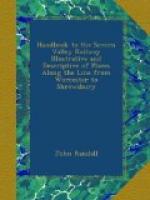On a red marlstone cliff, {11} rising above the river Salwarp, and overlooking the town of Droitwich, is the church of Dodderhill, belonging to the parish of that name. It gave shelter to the Royalists during the civil wars, and suffered much from an attack of the Parliamentary forces, who battered down its nave and tower. The former has never been rebuilt, and the latter, instead of being placed in the position it formerly held, has been made to fill up the south transept.
On the left of the line is the seat of Sir John Packington, the present member for Droitwich. It may be reached from the town by a pleasant walk; first by the side of the canal and river, and then through the park. Westwood was given by Henry VIII. to an ancestor of the present baronet, in consequence of his residence at Hampton Lovett having been injured during the civil wars; and the house is one of the most interesting specimens of Elizabethan architecture in the kingdom. The railway passes Hampton Lovett church, near which are neat model cottages erected by Sir John; and at a distance of eleven miles from Worcester we arrive at
HARTLEBURY.
Hartlebury, which is about a mile from the station, has been for a thousand years the residence of the bishops of Worcester; the old castle having remained entire until the middle of the 17th century, when, from having given shelter to the Royalists, it became a heap of ruins, and the present palace was erected in its stead. It is approached by a noble avenue of limes, and is surrounded by pleasure-gardens, fashioned out of its ancient moat, one portion of which is still a quiet lake. It has a park with well-timbered tracts adjoining, one of which is called the Bishop’s Wood, and near which is the famous Mitre Oak.
STOURPORT
Derives its name from the great basins constructed by Brindley upon the canal, and also from the river Stour, which here enters the Severn. The advantages of position led to the erection of large manufacturing establishments on the spot. Steam has been brought to aid the Stour, whose waters are pounded back to create a capital of force to turn great wheels that spin, and weave, and grind; whilst iron works, vinegar works, and tan works, upon a large scale, have also sprung into existence. On the opposite bank of the Severn, about three-quarters of a mile from Stourport, is Arley Kings, or Lower Arley; and about a mile lower down the river is Redstone Cliff, in which is the famous hermitage of Layamon, a monkish historian of the 13th century, who is said to have composed a “Chronicle of Britain,” embracing that mythical period extending from Brute to Cadwallader.
On leaving Stourport, the traveller passes Burlish Common, and plunging into a deep cutting, terminated by a dark tunnel, emerges in sight of the little town of




